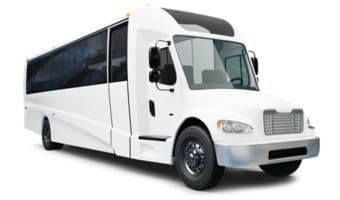Washington, DC charter bus rentals for student groups
Save the stress of planning a college trip by using a charter bus rental from Bus.com

Every year, students flock to Washington, D.C, eager to experience the international and political climate that D.C. uniquely offers. With embassies, museums, and the heart of the nation’s federal political system, there are items to attract students with diverse interests. Beyond the academic appeal, D.C. has opportunities across the arts: the Smithsonian Museum system, the theatre section downtown, and a happening food scene. Students who prefer sports have both Division I games they can attend, and professional sports teams like the Redskins, the Capitols, and the Wizards. Last, but not least, by far, DC has a busy nightlife and music scene in places like U Street and Adams Morgan.
cost-effectively
enhancements
Customer Support
Which bus type is right for me?
There are many different types of buses to consider when you’re booking your college trip. We have multiple sizes that can match group size and budget. The best selection for your college trip will depend on your specific needs. Here’s an overview of some commonly selected charter bus options.
Colleges and universities in Washington, DC
Washington, D.C., the capital of the United States, holds intrigue and mystery and appeal for many. Often students come for college and never leave. With so many premier colleges and universities it’s hard to decide what might be the best match for you. There are ones with religious affiliations, schools that are public and research-focused, and many with rich histories. Here are several to give you a brief taste of what the city has to offer.
Georgetown
Georgetown University was founded by Bishop John Carroll, a former Jesuit, in 1789, however it didn’t become affiliated with the Jesuits until 1805. He was a former Jesuit, because at the time, there was a suppression of the Jesuit order. They, like many colleges in the United States, have a sordid history: in 1838, they sold 272 slaves to two Deep South plantations, in order to raise funding. In 2001, the school installed its first lay President. Today the school has 12,000 students and five locations over 104 acres. Their motto is “Both into One” and they are passionate about social justice.
George Washington University
George Washington University was chartered by an act of Congress on February 9, 1821; only four other universities were chartered by Congress. Across its undergraduate and graduate students, it has enrollment of nearly 30,000 students. The school has several campuses: the main one is in Foggy Bottom (where it’s been since 1912), in the heart of DC and it has two satellite campuses in Virginia. The Foggy Bottom campus is on 43 acres and houses the Corcoran Gallery, located on The Ellipse. The University regularly hosts classes in partnership with area museums, labs, and monuments.
Howard University
Howard University, a Historically Black University (HBCU), was founded in 1867 when it received its charter from Congress. It is a private research university with 13 schools and colleges. The main campus is located in Northwest DC, just a hair away from U Street and Howard Theatre. Its campus spans more than 89 acres, as well as more than 100 acres in Beltsville. The school’s motto is “Truth and Service” and it seeks to prepare “men and women to advance social justice and the preservation of human liberty.” Its student body is roughly 9,000 students, representing all of the states and 66 countries.
Catholic University of America
Located in the Brookland neighborhood, Catholic University is a private Catholic pontifical university. Practically speaking, what this means is that the work that comes out of the school, as well as all the classes, are approved by the Holy See (Vatican). The university was founded in 1887 by Pope Leo XIII, primarily to serve graduate students. It wasn’t until 1904 that they began to offer undergraduate coursework. Today, the campus spans 176 acres and is easily seen from afar because of the Dome of the Basilica of the National Shrine of the Immaculate Conception, located on the campus. Catholic has hosted three popes over the years: Pope John Paul II, Pope Benedict XVI, and Pope Francis.
Gallaudet University
Gallaudet University was founded in 1864 by a Congressional charter. Prior to this, it had been established as a grammar school for deaf and blind children by Amos Kendall, in 1856. Kendall had donated two acres of his property to found the school and he convinced Congress to authorize the conferral of degrees in 1864. The school’s name was changed to Gallaudet College in 1894 to honor Thomas Hopkins Gallaudet (who founded the first school for the deaf in the United States). Today, the school functions as a primary source for “all things related to deaf people” for people who belong to both the deaf community and the hearing community.
University of the District of Columbia
The University of the District of Columbia has its roots in the school founded by Myrtilla Miner in 1851: Miner Normal School. The school was converted into a four-year teachers college in 1929, by a Congressional charter. Concurrently, Wilson Normal School (established in 1873) was also converted to a teachers college. Wilson worked with white women, Miner, with black women. After Brown v. Board of Education in 1954, the two colleges merged to become the District of Columbia Teachers College. In 1976, They were consolidated further with two other schools: Federal City College and Washington Technical Institute. As a whole, the schools moved forward as the University of the District of Columbia, with five colleges. Today the school has 81 programs for undergrads and grads.
Ready to get started?
Our online trip builder can help you find the right transportation for you







